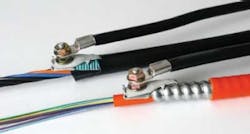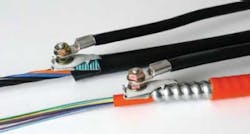Best practices for bonding and grounding armored fiber cable
Depending on the type of armor, bonding and grounding may be essential or unnecessary.
By Sara Chase, Corning Cable Systems
Armored fiber-optic cables are often installed in a network for added mechanical protection. Two types of armoring exist: interlocking and corrugated. Interlocking armor is an aluminum armor that is helically wrapped around the cable and found in indoor and indoor/outdoor cables. It offers ruggedness and superior crush resistance. Corrugated armor is a coated steel tape folded around the cable longitudinally. It is found in outdoor cables and offers extra mechanical and rodent protection.
Installing armored fiber-optic cable has several benefits, but one inconvenience is the need to bond and ground the cable. This inconvenience can be eliminated by using a dielectric-armored cable. Dielectric-armored cable options exist that offer the required protection without the hassle of grounding and bonding the armor, or the extra steps of installing a conduit and cable when the cable is without any armored protection.
Benefits of armored cable
During some fiber-optic installations there is a need to provide extra protection for the cable due to the installation environment. That environment may be underground or in buildings with congested pathways. Installing an armored fiber-optic cable in these scenarios would provide extra protection for the optical fiber and added reliability for the network, lessening the risk of downtime and cable damage due to rodents, construction work, weight of other cables and other factors.
Cable with Conduit | Interlocking Armor Cable | All-Dielectric Armored Cable | |
Cable Cost | $455 | $662 | $827 |
Conduit Cost | $240 | $0 | $0 |
Installation Cost for Cable and Conduit at $1.50/foot | $900 | $450 | $450 |
Total Install Cost Comparison | $1,595 | $1,112 | $1,277 |
Time to Access and Terminate | 35 minutes | 55 minutes | 40 minutes |
Time to Ground the Cable | 0 | 30 minutes | 0 |
An alternative to installing armored optical cable is to place conduit and pull in the fiber-optic cable. However, placing a single-armored fiber cable is usually the more cost-effective choice. There is no need to install conduit, resulting in a reduction in the installation cost by up to 40 percent and in the installation time by up to 50 percent. The table on this page shows a cost comparison of three installation methods in an indoor riser-rated environment for 300 feet of 12-fiber, 50-µm cable.
The corrugated (top) and interlocking (bottom) armored cables shown here are bonded. Note that a portion of the corrugated armored cable’s jacket has been removed to display the armor for illustrative purposes in this photograph. During an actual installation the armor remains covered by the cable jacket.
Why bond and ground?
Proper grounding and bonding is required for the safe and effective dissipation of unwanted electrical current, and it promotes personal and site safety. Typically, fiber-optic systems do not carry electrical power, but the metallic components of a conductive cable are capable of transmitting current. This would occur if a metallic piece of the cable—such as the interlocking or corrugated armor—were to come into contact or close proximity with electrical current from sources such as exposed wiring, faulty electrical systems, lightning or other events. This creates the potential for the occurrence of several hazards, such as electrical shock, fire, damage to electronics and system failures resulting in downtime.
Bonding and grounding of armored fiber-optic cable are simple steps in the installation process that are often misunderstood or overlooked. The National Electrical Code (NEC) and several industry standards have been established to promote safe and effective bonding and grounding practices of armored optical cables. Besides the NEC, local area networks (LANs) have traditionally relied on ANSI/TIA-568-C.0 Generic Telecommunications Cabling for Customer Premises, ANSI/TIA-569-B Commercial Building Standard for Telecommunications Pathways and Spaces, and ANSI-J-STD-607, Commercial Building Grounding (Earthing) and Bonding Requirements for Telecommunications for additional guidance. Data centers have also relied on ANSI/TIA/EIA-942 Telecommunications Infrastructure Standard for Data Centers.
Other resources on bonding and grounding best practices include documents published by the Institute of Electrical and Electronics Engineers (IEEE) and the BICSI Telecommunications Distribution Methods Manual (TDMM). Additionally, a location may have specific local codes pertaining to grounding and bonding that may differ from the current edition of the NEC and industry standards. It is recommended to consult the local authority having jurisdiction with specific questions regarding compliance.
Pert Article 770 of the NEC, a fiber-optic cable containing non-current-carrying metallic components, such as armor or metallic strength members, is considered conductive. This is why conductive fiber-optic cables should be bonded and grounded as specified in NEC Article 770.100.
How to bond and ground
Understanding how to bond and ground a fiber-optic system with armored cable can be confusing. First, it is important to understand the difference between the terms bonding and grounding. According to the NEC and industry standards, bonding is the permanent connection of metallic parts to form an electrical path that will be conductive and continuous. Grounding is the act of connecting that path to the earth or some conducting body that serves as the earth. When all the components of a system are properly bonded together and grounded to the earth, the risk associated with electrical current harming personnel or damaging property and equipment is reduced.
The first step is to connect/bond the cable armor to a bonding or grounding electrode conductor. This can be accomplished right after the cable is accessed, and the armor is exposed. A bonding conductor or jumper is a short length of conductor, such as copper wire, that maintains electrical conductivity between two metal objects. The bonding conductor is required to be UL-listed and made of either copper or another corrosion-resistant conductive metal. This stranded or solid wire can be insulated, covered or bare. Most cable manufacturers supply an insulated, UL-listed 6-AWG copper strand. The 6-AWG size is preferred for the bonding conductor because that allows it to comply with both the NEC and ANSI-J-STD-607. The bonding conductor can be attached to the armor by the use of a listed clamp, lug or connector, as stated in NEC Article 250.70.
Once the clamp is installed, vinyl tape can be applied around the clamp and exposed armor to protect the installer and the fiber from any sharp edges where the armor is exposed.
For the conductive fiber-optic cable to be fully grounded, the bonding conductor from the cable needs to be bonded to the intersystem bonding termination (if present), or another accessible location per NEC Article 770.100. The intersystem bonding termination is the device that connects the bonding conductors to the building’s grounding electrode and ultimately, to earth. Typically this is accomplished by connecting the bonding conductor to a dedicated path back to the telecommunications main grounding busbar (TMGB) or the telecommunications grounding busbar (TGB). The dedicated path can be a direct run or created by attaching to a rack or cabinet’s bonding system that bonds the rack or cabinet back to the TMGB or TGB. Specific requirements on how the TMGB or TGB are designed can be found in ANSI-J-STD-607 and other industry standards. When the armored cable is correctly bonded and grounded, it minimizes the risk of unwanted electrical current that could potentially harm personnel, property or equipment.
The all-dielectric armored cable shown here is an alternative to cable-in-conduit or a bonded and grounded conductive cable. An all-dielectric armored cable has no metallic components and therefore does not require bonding or grounding.
The dielectric alternative
If the fiber-optic cable in a system needs extra protection, there is an alternative to using conduit or a bonded and grounded conductive cable, such as an all-dielectric armored cable.
Because all-dielectric armored cable has no metallic components, there is no need to ground or bond the cable. Also, the cable design allows for quicker and safer cable installation because compared to conductive cable it is lighter, easier to access, and the armor does not produce sharp edges when accessed. Additionally, it still offers the needed protection from environmental hazards as a conductive armored cable would.
Installing an all-dielectric armored cable is just as cost-effective as installing interlocking armored cable, yet it eliminates the time needed to bond and ground the armor. Furthermore, it is more cost-effective than installing conduit and an all-dielectric cable.
Following correct bonding and grounding procedures is important when working with armored cables. Many times, however, it is overlooked when working with fiber-optic cable. If metallic armor is used, bonding and grounding of the armor is essential to protect personnel and equipment. However, that step can be avoided by using a dielectric armored cable.
Sara Chase is technical market specialist with Corning Cable Systems (www.corning.com/cablesystems). This article addresses the topic of grounding and bonding telecommunications cable as it is addressed in the National Electrical Code. Visit www.cablinginstall.com to view a web seminar on the NEC and cabling, available on-demand.
Past CIM Issues


